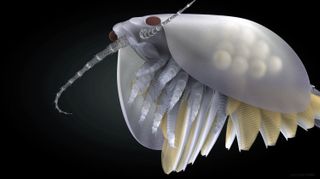Ancient, Mustached Sea Creature Used Spiny Limbs to Disembowel Prey
It took more than 100 years, but researchers have finally come up with a scientific description for a weird, thumb-size sea creature with large eyes, a "mustache" and fringed paddles for zipping through the ocean during the Cambrian period .
The ancient, shrimp-like marine predator — known as Waptia fieldensis — was a gold-medal swimmer. While it sped through the water, it likely used its front, spiny limbs to capture and disembowel tasty prey. When the tiny creature took a break, it likely used these limbs to cling to structures, such as sponges.
"We think that Waptia was a capable swimmer," study lead researcher Jean Vannier, a senior researcher of geology at the French National Center for Scientific Research, said in a statement. "With the help of all its sensing organs, [it] would have actively hunted its preys, grabbing them between its elaborate [spiny] appendages, resting perhaps from time to time on sponges. Unfortunately, we lack actual gut contents to figure out its exact diet." [See images of Waptia fieldensis fossils and illustrations]
The American paleontologist Charles Doolittle Walcott (1850-1927) first discovered W. fieldensis in 1909 in the fossil-rich Burgess Shale deposit of British Columbia, Canada. In a brief 1912 description of the creature, Walcott called it "one of the most beautiful and graceful of the remarkable crustaceans from the Burgess Shale."

However, even though scientists have studied different aspects of W. fieldensis over the past century — for instance, a fossil of a W. fieldensis mother carrying about two dozen eggs is the earliest example of brood care with preserved embryos on record — no scientists have put together a formal, in-depth description of the critter. So, a team of international scientists decided to do just that, publishing their results online Wednesday (June 20) in the journal Royal Society Open Science.
To investigate, the team examined more than 1,800 W. fieldensis specimens, looking at magnified images of the species' fossilized brain, appendages and eyes. As an added bonus, the analysis also showed how the big-eyed beasties played a key role in the evolution of arthropods, the biggest phylum of animals alive today, which includes invertebrates such as insects, spiders and lobsters.
Deep-dive description
In the description of W. fieldensis, the researchers noted that the creature had a saddle-shaped upper shell, or carapace. It also had stalked eyes, a pair of long antennae that formed a sort of mustache and chewing appendages known as mandibles (so, it's also called a mandibulate).
Sign up for the Live Science daily newsletter now
Get the world’s most fascinating discoveries delivered straight to your inbox.

Moreover, W. fieldensis is the first Cambrian arthropod on record to have mandibles with preserved palps — appendages that usually help with touch and taste, the researchers said. It also had another mouthpart appendage known as maxillules that are present in other mandibulates. But, surprisingly, it didn't have an appendage between its antennae and mandibles — a condition that's seen only in terrestrial mandibulates such as centipedes and insects, the researchers said. Meanwhile, marine mandibulates, such as crustaceans, have a second pair of antennae in this spot.
"We thought so far that the loss of the second pair of antennae was related to the modification of the head during the adaptation to life on land," Vannier said. "Waptia and its relatives are challenging this view and raise thought-provoking questions on the evolution of the arthropod head."
The creature sported fringy paddles known as lamellae on its bottom side, which helped it swim. At its rear end, W. fieldensis flaunted a shrimp-like tail.
Original article on Live Science.

Laura is the archaeology and Life's Little Mysteries editor at Live Science. She also reports on general science, including paleontology. Her work has appeared in The New York Times, Scholastic, Popular Science and Spectrum, a site on autism research. She has won multiple awards from the Society of Professional Journalists and the Washington Newspaper Publishers Association for her reporting at a weekly newspaper near Seattle. Laura holds a bachelor's degree in English literature and psychology from Washington University in St. Louis and a master's degree in science writing from NYU.
